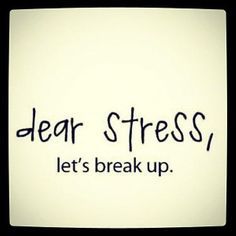 How do you know if you’re stressed? Most of us have a “tell” – that’s poker speak for signals that disclose your cards. In this case, a Do you sweat a lot? Is your heart racing, like you just ran up a flight of stairs? Do you feel an itch at the back of your throat signalling an impending illness?
How do you know if you’re stressed? Most of us have a “tell” – that’s poker speak for signals that disclose your cards. In this case, a Do you sweat a lot? Is your heart racing, like you just ran up a flight of stairs? Do you feel an itch at the back of your throat signalling an impending illness?
When we’re stressed, hormones like cortisol flood our systems, producing the “fight or flight response” making our heart rate goes up, and forcing us to breathe more heavily since we require more oxygen as our blood vessels constrict. This is our stress response.
Alternatively, we have a relaxation response which is the reverse of the uncomfortable things listed above: our heart rate goes back to normal and our breathing slows down as we use less oxygen. Our blood pressure decreases too.
We don’t really have a choice over what triggers our stress response but there are ways to manage and undo it’s effects. Here are five ways that you can decompress and get your stress levels down:
Take a big breath and repeat:
Yes, simple as that. However, there is a proper way to do it. Yogis and Yoginis swear by a deep breathing technique to help clear the mind and calm the body down. I have discussed some meditation techniques earlier in the article “A Mind Full of Light”. The article broadly discusses some tips on how you can start meditating.
Need another reason to get started on meditation? Deep breathing exercises help reduce stress and relieve tension just by giving you an extra boost of oxygen.
Take a walk:
Walking clears your head by putting your body into a state of meditation, specifically via a phenomenon known as “involuntary attention”. This is the act of engaging in an activity that allows for reflection all while doing something that holds our attention. Walking also gives you a boost of endorphins, you know those feel good hormones released when you exercise.
Day dreaming Day dreamer:
Try this while sitting at your desk, waiting for your food, hiding in an empty conference room – or wherever you feel less self conscious: visualize a calming scene in your mind’s eye. Picture the scene vividly and in the most accurate detail you can picture. Try these as visualization prompts:
- A sunny day at the beach with clear blue skies and clear waters.
- A fun future vacation with family or friends.
- A mountainside getaway with lush forests and hot cocoa.
- Going on a movie and dinner date with your celebrity crush.
- Completing a pet project.
Now, once you’re done doing that, don’t you feel so much better? Visualizing happy scenes recognizes the power of “guided imagery” to bring on a relaxation response. Simply put, dreaming about something happy makes you happier and therefore, less stressed.
Progressive Muscle Relaxation
The Huffington Post outlines the steps to Progressive Muscle Relaxation with this: “Start with your toes and work your way up: tighten your foot muscles as much as you can, then relax them. Make your way up, tightening and relaxing each muscle until you’ve finished with your face. It may seem silly, but this practice can help reduce anxiety and stress and is often recommended to patients who suffer from depression and anxiety disorders”.
And last but not least…
Finding the Funnies:
A good laugh is the most awesome ever relaxation technique. The Mayo Clinic explains that “Laughter enhances your intake of oxygen-rich air, stimulates your heart, lungs and muscles, and increases the endorphins that are released by your brain”.
Counter intuitively, laughter first activates your stress response and then deactivates it, creating a kind of “roller coaster” that leads to a feeling of relaxation and boosts your endorphin. We love endorphin!
So go ahead, watch those viral funny cat videos. Read the newspaper funnies. Pick up a funny book or comic. You’ll feel so much better after a good hearty laugh. As always, remember to: Stay Humble, Hustle Hard. Good luck!
Written by Jaie O. – The Help